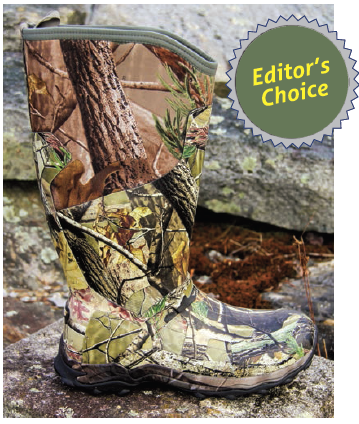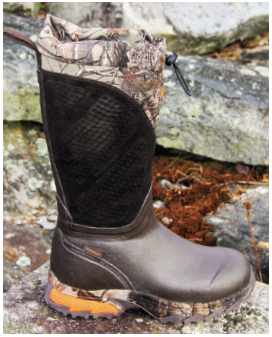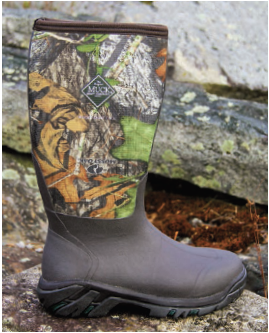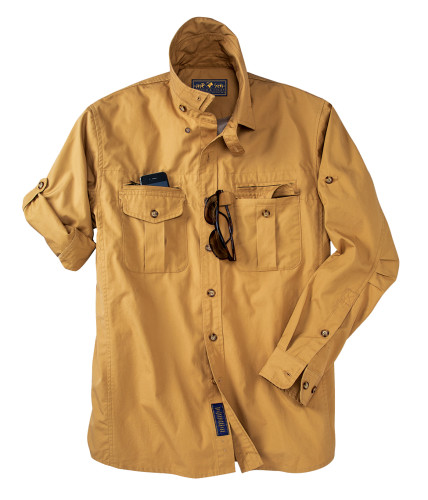Comparing, contrasting & torture testing nine pairs of pull-ons
By Ralph P. Stuart
Waterproof leather is an oxymoron. There, I’ve said it. I don’t care how much silicone, wax or miracle goo you slather on tanned animal hide; keep treated leather wet for long enough, and water’s going to seep through. Nowhere is this more evident than with boots. It doesn’t matter what the manufacturer says or what dressing you use, if you strap on a pair of leather boots and rinse, dry and repeat enough times, you’re going to wind up with wet feet. And nothing ruins a hunt faster than wet feet. That said, there are plenty of situations where leather boots work great—like walking prairie grasslands, trekking the high country and crisscrossing dry cropfields. But when my plans call for slogging through cattail sloughs or mucking around in alder bottoms, I reach for footwear that’s going to keep out water: rubber boots.
I went to rubber when I started snow-tracking deer. Uninsulated knee-highs served well for all-day walking, and though they were too thin (read: cold) for standing around long, they allowed me to feel every stick underfoot as I tried slipping up on a buck. In time I began wearing rubber boots for other purposes: waterfowling in swamps and wet fields, turkey hunting during spring mud season, bird planting and laying drag trails for dog training. Finally I made the leap to wearing them for upland hunting in my often-wet New England coverts. And I never looked back.
For upland pursuits, I look for boots made for walking. Something over the calf and close to the knee. Lighter is better, and when it comes to insulation, less is more. I like boots that fit at the ankle and are roomy enough for tucking in pant legs in tick country. I need ample arch support and soles that provide traction and purge mud. I also like boots that I can remove without a jack or giving myself a hernia.
With these criteria in mind, this past spring I approached manufacturers with the idea of wear-testing their boots. I told them that they could choose the model, but I was looking for boots suitable for early season upland hunting. Size 10, thank you very much. And, no, I don’t have a preference in camo patterns.
As the boxes began piling up in my office, I designed a test course that would make a ninja warrior proud. From the trailhead, I would walk a half-mile on a flat two-track before stepping into a stream and following it up-current for a hundred yards. Next I would stand in a calf-deep pool for five minutes before exiting into ankle-deep mud, climbing a steep embankment, sidehilling in loose dirt, scrambling up a rocky slope and returning to the main trail. Then there would be a half-mile trek across tablelands before I cut through the woods—pushing through thick growth and scrambling over deadfalls—on a steep descent back to the trail. The last quarter-mile would be a jog to the trailhead. All this would be navigated in the morning before my first cup of coffee while trying to avoid the family’s bootlicking hound. Brutal.
The test took several weeks to complete, and in that time I traveled countless miles, traversed mountains’ worth of vertical feet and spent hours weighing, measuring, stretching and otherwise analyzing the various boots. After all was said and done, I’m happy to report that none of the subjects failed to the point of leaking, but I did find that all were not created equal. As with any piece of gear, some were simply better designed or suited for different purposes. Hopefully my findings will help you narrow the choices in your own rubber match.
Bogs World Slam (Editor’s Pick)
The third-lightest boots in the test, Bogs World Slams are built on a running-shoe platform—and it shows. I felt like I could have walked in theseall day. Combining rubber with neoprene, the boots also have 3mm Neo-Tech insulation and 2mm Airmesh, giving them just enough warmth to ward off the morning chill. They slipped on easily and offered good ankle support and plenty of room at the foot. The thermo-molded EVA midsole provided good arch support, and the air-bob sole gripped rocks well and expelled mud quickly. These boots excelled in overall comfort and were fine to run in—and at the end of the test they pulled off easily. My feet remained dry, thanks to the interior moisture-management system. These boots would work very well for hunting in warm or cold weather throughout the season. Available in Realtree, Mossy Oak and green. Price: $180. Bogs, 877-321- 2647; www.bogsfootwear.com.
Bushnell Archers, as the name suggests, were designed for bowhunting. With 400 grams of Thinsulate Ultra insulation and a removable insole with a compartment for inserting a heat pack, they were fashioned for getting to and from a stand and waiting in the cold for a buck to walk by. They were certainly the funkiest-looking boots in the bunch, with Realtree fabric uppers, suede side patches, brown rubber bottoms, a camo-wrap EVA midsole, and a brown sole with orange heel accents. Inside is a 3.5mm full neoprene sock with a fleece lining and a dual-density heel cushioning system. The boots pulled on easily and were form-fitting at the foot. In fact the Archers provided one of the most pleasant walks, with my feet feeling like they were being cradled in comfort. There was good ankle and arch support, and the boots performed well while sidehilling and clambering over rocks. The mistake I made was cinching the top drawstring, as my feet heated up like they were in an oven. (I loosened it halfway through the test and cooled down again.) Another drawback is that the boots would not pull off without a jack. I could see going to these boots later in the year, but for an early season hunt they are simply too warm. Price: $180.
Bushnell Performance Footwear, 800-325-6116; www.bushnell.com.
With an 8mm-thick combination of neoprene, breathable mesh and fleece as well as fully clad (for puncture resistance) rubber uppers, Cabela’s Dura-Trax II Pros were some of the heaviest boots in the test. Even so, they felt lighter than they are, thanks to a good fit and slim design. The boots pulled on easily, and cinching side gussets at the top provided plenty of room for large calves and tucking in pant legs. EVA midsoles and fiberglass shanks offered ample support for crossing uneven terrain, and self-cleaning outsoles gripped slippery surfaces well. A kick plate at the heel made for easy removal. These boots are designed to be comfortable in temperatures from 50°F to -40°F, which explains why my feet heated up quickly while walking. For this reason, I would hold off wearing these until at least midseason. Available in Mossy Oak Break-Up Infinity and Realtree AP. Price: $150. Cabela’s, 800-237-4444; www.cabelas.com.
Grub’s Treeline 8.5 SP
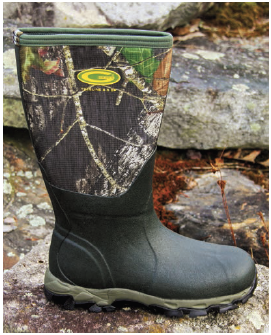
Available in Mossy Oak New Break-Up. Price: $155. Grub’s, www.grubsbootsusa.com.
Irish Setter Rutmaster
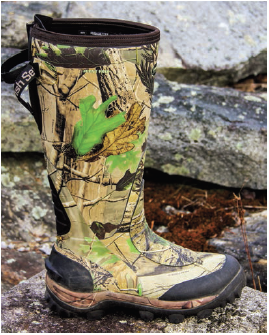
LaCrosse AeroHead 3.5

Woody Sport Cools were the lightest boots in our test, and they were made for covering ground. They were snug at the ankle, making them tough to slip into, but once they were on, they felt as comfortable as sneakers. Made with 4mm neoprene uppers and a molded rubber outsole, these boots were designed for temperatures from sub-freezing to 95°. The XpressCool lining pulls moisture away from the foot and spreads it out to evaporate quicker and create a cooling effect in warm conditions. The boots’ slim profile combined with a molded EVA midsole and 6mm Nitracel sock liner made for pleasurable walking (and running), and good ankle support and tread aided in climbing steep banks. The neoprene did bunch a bit at the ankle and ended up rubbing, but it wasn’t bad. And a jack was required to remove the boots. Another downside is that there was very little room at the top for large calves or tucking in pant legs. Overall, these boots would be fine for early season long-distance trekking. Available in Mossy Oak Obsession. Price: $155. The Original Muck Boot Co., 800-777-9021; www.muckbootcompany.com.
Rocky MudSox Neoprene
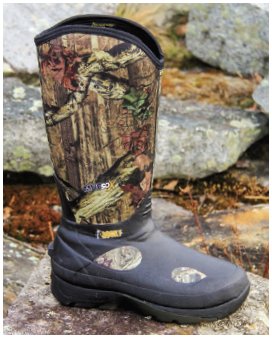
Rocky Boot, 866-442-4908; www.rockyboots.com.
Under Armour H.A.W. (Best Value)
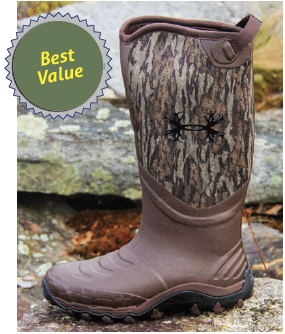
Click here to purchase this issue.

Never miss an issue. Subscribe to Shooting Sportsman magazine.
Read our Newsletter
Stay connected to the best of wingshooting & fine guns with additional free content, special offers and promotions.



